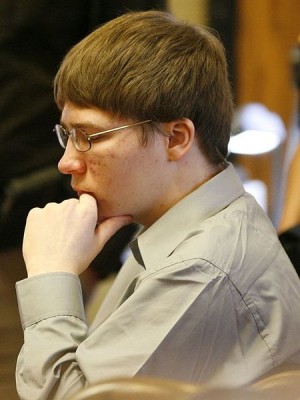7th Circuit refuses to reinstate conviction of Brendan Dassey in 'Making a Murderer' case

Brendan Dassey. Photo by Tracy Symonds-Keogh, via Wikimedia Commons
Updated: A federal appeals court has refused to reinstate the conviction of a Wisconsin man convicted of helping his uncle kill a woman in a murder case featured in the Making a Murderer Netflix series.
The Chicago-based 7th U.S. Circuit Court of Appeals affirmed a ruling that overturned the conviction of Brendan Dassey, report USA Today and the Associated Press.
The Wisconsin Department of Justice anticipates either seeking en banc review of the case by the 7th Circuit or appealing to the U.S. Supreme Court.
“We are evaluating the 2-1 decision from the court,” Johnny Koremenos, the Wisconsin Department of Justice’s director of communications and public affairs told the Milwaukee Journal-Sentinel. “We anticipate seeking review by the entire 7th Circuit or the United States Supreme Court and hope that today’s erroneous decision will be reversed. We continue to send our condolences to the Halbach family as they have to suffer through another attempt by Mr. Dassey to re-litigate his guilty verdict and sentence.”
A federal magistrate judge who overturned the conviction last August had found police used coercive techniques in getting 16-year-old Dassey to confess to helping his uncle, Steven Avery, kill photographer Teresa Halbach.
Judge Ilana Rovner wrote the decision (PDF) for Dassey, while Judge David Hamilton dissented.
Halbach, a 25-year-old photographer for Auto Trader Magazine, was killed after being called to take photos of a car at Avery’s salvage yard. Her “brutally burned body” provided few clues about the death, Rovner said. Witnesses had reported a large bonfire outside Avery’s residence on the night of Halbach’s death.
Dassey had an IQ that fell “fairly below an average range of intelligence,” Rovner said. A psychological expert said he was highly suggestible, docile and withdrawn.
Dassey originally told investigators that he had helped his uncle load tires and an old van seat onto the bonfire that evening, and he saw nothing unusual. He changed his story over time, “increasing his culpability in response to suggestions by the investigators,” Rovner said.
In a March 1 confession, Dassey said he had helped his uncle clean some fluid from a vehicle from the garage floor. The story changed “after much encouragement,” and Dassey said he helped his uncle put Halbach’s body in the bonfire, Rovner said.
In a final telling of the story, Dassey “admitted to a horrific series of crimes—raping Halbach, cutting her throat, tying her up, cutting her hair, and then taking her to the garage where Avery shot her in the head and the two of them disposed of her body in the fire,” Rovner said.
Dassey had told his initial defense lawyer, Len Kachinsky, that he was innocent, but Kachinsky told the media his client was sad, remorseful and overwhelmed, Rovner said. According to media reports, Kachinsky blamed Avery for “leading Dassey down the criminal path” and said he had not ruled out a plea deal. Kachinsky later testified that he made the statements so Dassey’s family would become accustomed to the idea that Dassey would take a legal option they didn’t like.
Kachinsky asked his investigator to compel Dassey to confess to get Dassey’s cooperation in Avery’s prosecution. The investigator told Dassey his lie detector test showed deception, though it was inconclusive, and told him he could spend the rest of his life in prison because “you did a very bad thing.” Dassey originally told the investigator “I don’t know [if I’m sorry] because I didn’t do anything.” After being told he did a bad thing, Dassey responded, “Yeah, but I was only there for the fire.”
Dassey finally confessed, providing another version of the story. Kachinsky set up another interrogation with police, and did not accompany Dassey there. Dassey confessed yet again during the May 13 police interrogation, though the details differed from the May 1 confession.
The trial court learned that Kachinsky allowed his client to be interrogated without counsel present and held a hearing on his effectiveness. Kachinsky withdrew from the representation.
A state court considering Dassey’s appeal had stated the general standard for evaluating whether a confession is voluntary, but it didn’t apply the standard and didn’t note that juvenile confessions require more care, Rovner said.
“If a state court can evade all federal review by merely parroting the correct Supreme Court law,” Rovner wrote, “then the writ of habeas corpus is meaningless.”
Defendant’s last name corrected at 4 p.m. Last updated June 23 to note comment from the Wisconsin Department of Justice.



